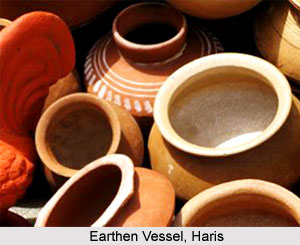 Clay crafts in West Bengal include a number of items that serve utilitarian purposes. In marriage ceremonies of Bengal vessels of different shapes and sizes are necessary for sending gifts to bride`s and bridegroom`s houses, especially varieties of sweets. Earthen vessels were used in the past, not only because glass, aluminium or stainless steel were not in vogue, but also because earthen pots were considered more sacred and auspicious than glass-pots or metal-pots. There are families among the upper class Hindus who still adhere to this tradition of sending presentations of sweets during marriage ceremonies, and food-offerings of deities, in earthen vessels, which are often beautifully shaped and decorated. And the common village people, who are poor, have no other alternative but to use earthen vessels, because there are cheaper than other kinds of metal-vessels.
Clay crafts in West Bengal include a number of items that serve utilitarian purposes. In marriage ceremonies of Bengal vessels of different shapes and sizes are necessary for sending gifts to bride`s and bridegroom`s houses, especially varieties of sweets. Earthen vessels were used in the past, not only because glass, aluminium or stainless steel were not in vogue, but also because earthen pots were considered more sacred and auspicious than glass-pots or metal-pots. There are families among the upper class Hindus who still adhere to this tradition of sending presentations of sweets during marriage ceremonies, and food-offerings of deities, in earthen vessels, which are often beautifully shaped and decorated. And the common village people, who are poor, have no other alternative but to use earthen vessels, because there are cheaper than other kinds of metal-vessels.
Of these earthen vessels some interesting varieties are found in Bankura, Midnapore and Murshidabad which are painted and decorated. Harhis are not painted in all places, and even where these are painted, the painting is not done by the professional potters of Kumbhakar caste, but by Patuas or scroll-painters, as in Midnapore. In Bankura the vessels are not painted by brush, but etched and engraved with pointed needles by potters. There are variations in the shapes and sizes of the vessels in different areas, as in Rajagram and Sonamukhi of Bankura district, but the etchings of geometric and symbolic designs on the vessels are almost similar in both the places. The designs are geometric and symbolic, and there is `fish`. The patuas paint flowers and leaves with fish. `Fish` is a common subject in all drawings on these auspicious vessels as it stands for fertility. The other designs are of trees and flowers, symbolically executed.
Formerly in some areas these vessels were painted with different scenes of marriage ceremony like palanquin with bride and bridegroom, reception of the bride after marriage at her father-in-law`s house etc. The composition of the scenes with colour was done. Such painted vessels are not found now and the potters, also their patrons, have vanished from the social scene. Some fragments and survivals of this unique piece of pottery can still be traced in the store-rooms of the old landed aristocracy in Murshidabad, for whom mainly the potters produced these painted terracotta vessels.



















